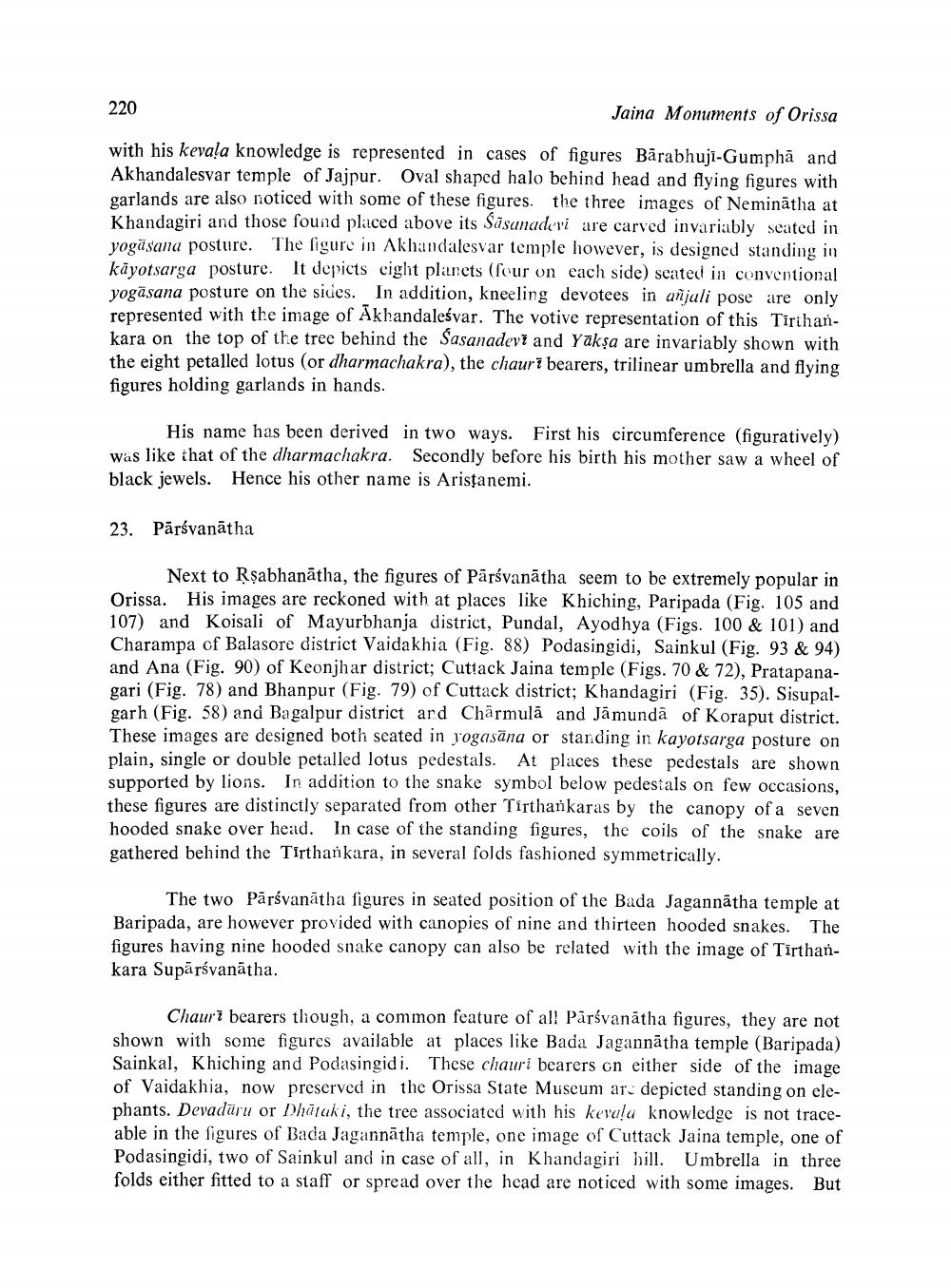________________
220
Jaina Monuments of Orissa
with his kevala knowledge is represented in cases of figures Bārabhuji-Gumphā and Akhandalesvar temple of Jajpur. Oval shaped halo behind head and flying figures with garlands are also noticed with some of these figures. the three images of Neminātha at Khandagiri and those found placed above its Sāsunadevi are carved invariably seated in yogäsana posture. The figure in Akhandalesvar temple however, is designed standing in käyotsarga posture. It depicts cight planets (four on each side) scated in conventional yogāsana posture on the sides. In addition, kneeling devotees in anjali pose are only represented with the image of Akhandaleśvar. The votive representation of this Tirthankara on the top of the tree behind the Sasanadevi and Yakșa are invariably shown with the eight petalled lotus (or dharmachakra), the chauri bearers, trilinear umbrella and flying figures holding garlands in hands.
His name has been derived in two ways. First his circumference (figuratively) was like that of the dharmachakra. Secondly before his birth his mother saw a wheel of black jewels. Hence his other name is Aristanemi.
23. Pārsvanātha
Next to Rşabhanātha, the figures of Pārsvanātha seem to be extremely popular in Orissa. His images are reckoned with at places like Khiching, Paripada (Fig. 105 and
popular in 107) and Koisali of Mayurbhanja district, Pundal, Ayodhya (Figs. 100 & 101) and Charampa of Balasore district Vaidakhia (Fig. 88) Podasingidi, Sainkul (Fig. 93 & 94) and Ana (Fig. 90) of Keonjhar district; Cuttack Jaina temple (Figs. 70 & 72), Pratapanagari (Fig. 78) and Bhanpur (Fig. 79) of Cuttack district; Khandagiri (Fig. 35). Sisupalgarh (Fig. 58) and Bagalpur district ard Chārmula and Jāmundā of Koraput district. These images are designed both seated in yogasāna or standing in kayotsarga posture on plain, single or double petalled lotus pedestals. At places these pedestals are shown supported by lions. In addition to the snake symbol below pedestals on few occasions, these figures are distinctly separated from other Tirthankaras by the canopy of a seven hooded snake over head. In case of the standing figures, the coils of the snake are gathered behind the Tirthankara, in several folds fashioned symmetrically.
The two Pārsvanātha figures in seated position of the Bada Jagannātha temple at Baripada, are however provided with canopies of nine and thirteen hooded snakes. The figures having nine hooded snake canopy can also be related with the image of Tirthankara Supāsávanātha.
Chauri bearers though, a common feature of all Pārsvanātha figures, they are not shown with some figures available at places like Bada Jagannātha temple (Baripada) Sainkal, Khiching and Podasingidi. These chauri bearers on either side of the image of Vaidakhia, now preserved in the Orissa State Museum arc depicted standing on elephants. Devadāru or Dhālaki, the tree associated with his kevala knowledge is not traceable in the figures of Bada Jagannātha temple, one image of Cuttack Jaina temple, one of Podasingidi, two of Sainkul and in case of all, in Khandagiri hill. Umbrella in three folds either fitted to a staff or spread over the head are noticed with some images. But




